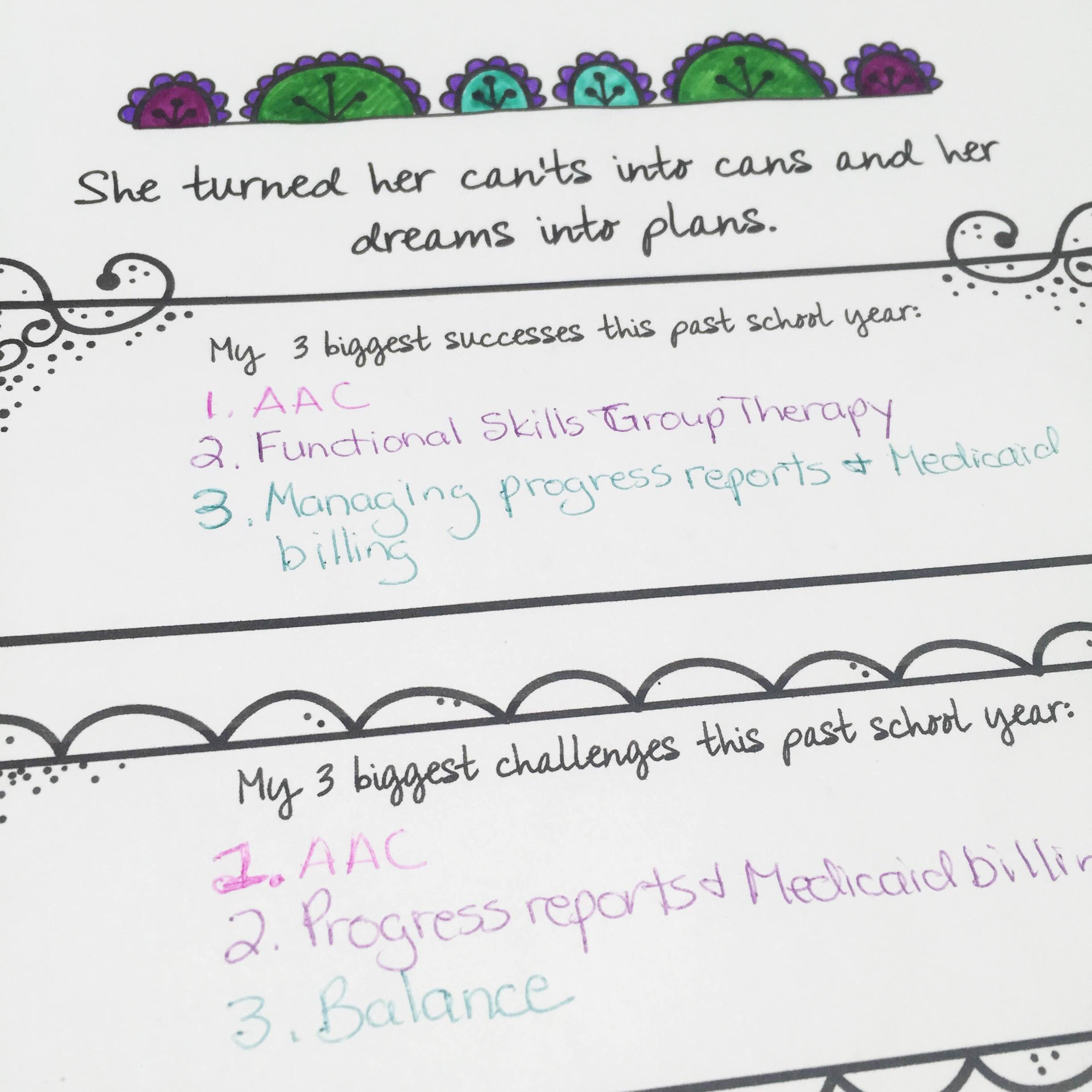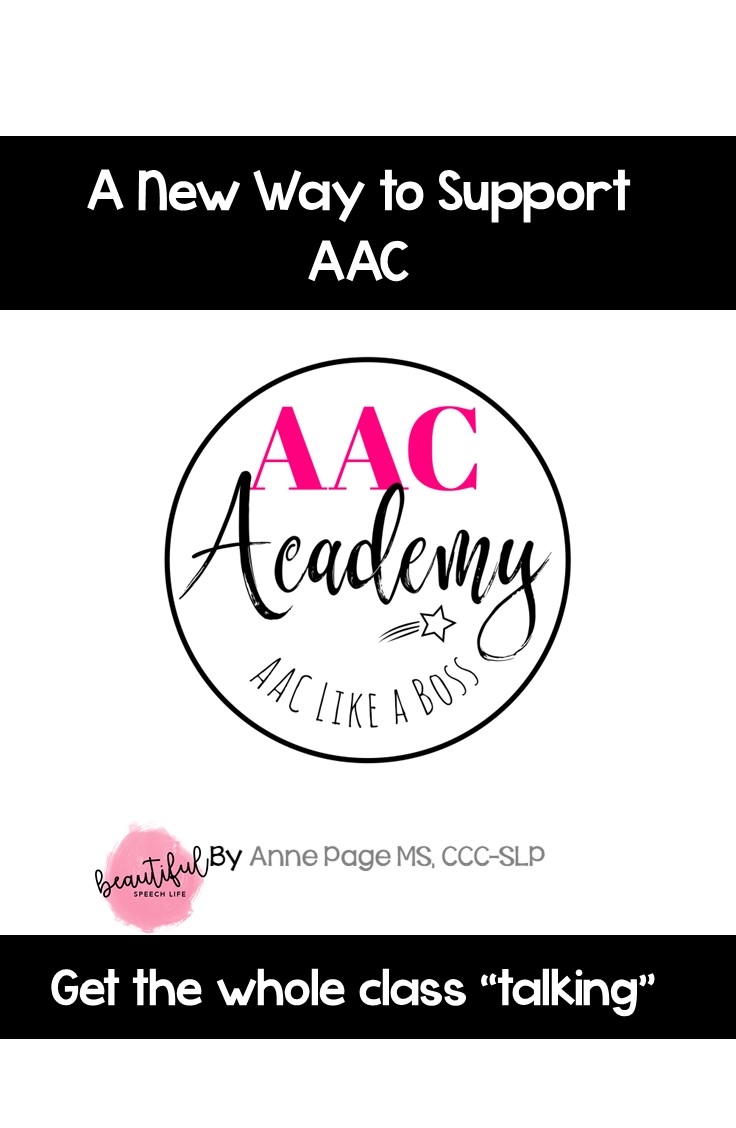Last day of school…ah! Such a great feeling.
That was a week and a half ago. I was end-of-the-year-marathon tired. But now I’m feeling refreshed and re-energized. I want to look back on the school year while it’s still fresh in my mind.

Year End Review Calendar Page
One thing that was really new for me was being the lead for the newly formed Assistive Technology Team for our district. I learned a lot from that and had to push myself to try some things I really wasn’t sure about. Today, I’m sharing three tips for how to AAC Like a Boss, even when you’re a beginner.
TIP #1 You don’t need to know EVERYTHING at first
I learned very quickly just because I’m the lead, it doesn’t mean I have to know everything. I think I had “Imposter Syndrome” for a little while. Have you heard of that? It’s when you think you’ll be exposed as a fraud because you’re just not good enough. Harsh right? Sometimes I’m my own worst critic.
What I figured out is that I don’t have to know everything there is to know about AAC and assistive technology. I don’t have to have all the answers right away, I just need to be willing to find them. Within the online SLP community there are some amazing resources. Dr. Carole Zangari’s award winning blog Praactical AAC is a gold mine of information. Susan Berkowitz at Kidz Learn Language is really helpful with her blog as well. Both of these SLPs truly AAC-like-a-boss and are so forthcoming in helping their fellow SLPs. Another great resource where you can ask specific questions is the Facebook group AAC for the SLP.
TIP #2 Be Resourceful
Working at a Title I district with very limited materials, I have to be extremely resourceful. This year I learned how to adapt toys to be switch activated. These are toys that move and/or sing when you squeeze their paw or hand. Some of our students don’t have the fine motor skills to be able to do this. It was really empowering to make such a fun item accessible for them. I even got to solder. The workshop was put on by our wonderful Arizona Technology Access Program. (You can google to see what programs your state might have.)
I was so happy with the dancing monkey I adapted. Until I got to school the next day and realized we didn’t have any switches that fit him. I figured I’d just buy one. But then I saw the price; $50 for one little switch! Back to the drawing board.

Adapted Switch Toy
Sooooo I signed up for a Make Your Own Switch Workshop. There I was able to make two switches for just $10. We adapted answer buzzers ( 4 for $16.00 at Walmart). The time I spent to adapt two switches was about 90 minutes, the first one took the longest.

Adapt a Switch
The bonus was sitting next to two parents of children with autism. They were making the switches for their kids. How cool is that? Talking to them in a casual setting about their experiences and expectations was so enlightening. I really got some insight into what they struggle with.
TIP #3 You Don’t Have to Start High Tech
The other thing I learned, in a really fundamental way, is that assistive technology does not need to be high tech at first. It seems that many parents, teachers and staff immediately think “voice activated device” or “get them an iPad”. AND that this technology will magically and immediately give the student language skills the second they receive it. If only!
Students need to learn to label, request, comment, command and greet. A machine can’t teach them these skills, but we can. A voice generating device may be exactly what they need eventually. But sometimes we can’t get one right away. We can still teach them that using symbols(voice activated or pictures) gives them the power to express what they want, when they want.
With many of our students, we started with low tech Core Vocabulary Boards and Go Talk Pages. We could get started right away with these because they’re inexpensive to create and so accessible. It was easier to get “buy-in” from support staff because they saw it working.

Core Vocabulary
We used The Dynamic Learning Map Core Vocabulary; a list of 40 words that have been proven to be most effective socially and academically for students with significant cognitive disabilities. Developed at the Center for Literacy and Disability Studies at The University of North Carolina at Chapel Hill, these 40 words are based on AAC research. I’ll provide a link to more information below. Next week, I’ll talk more about core vocabulary boards and how I used them in group therapy with great success!
In summary, you CAN AAC-Like-a-Boss. Just remember these three tips:
1. You don’t need to know everything.
2. You can be resourceful.
3. It doesn’t have to start out high tech.
I know it can seem scary but we SLPs know language. Remember AAC is just another way to facilitate language.
Whether you are reviewing your year or you’ll be working this summer, I hope you found something helpful here. If you would like a FREE Summer SLP Like a Boss planner to help you with your reflection and planning, click here.
If you are interested in a FREE video tutorial on how to make a switch, let me know in the comments below.
SLP-Like-a-Boss,
Anne
Links: Praactical AAC
Dynamic Learning Map Core Vocabulary
How Facebook Can Make You a Better SLP

 Hey there I’m Anne Page. I help heart centered SLPs and educators put the fun in functional communication.
Hey there I’m Anne Page. I help heart centered SLPs and educators put the fun in functional communication. 
Great advice!
Thanks Kristin!
Yes!!!!!!!! Love the tips. Openness to learning from others and seeing the competence in all our students are fundamental to successful AAC implementation. Helping our students see themselves as communicators, that their ideas are important and we want to hear it, and that we will persist in supporting this learning make this work meaningful and rewarding.
Amen Jasmine! I agree this work is so meaningful and rewarding. And when a student makes a breakthrough it’s just the best feeling ever.
I’d love to see a video tutorial on how to make a switch. I really appreciated your post on this. I’d also like to see what you did with your “Functional Skills Group Therapy ” that you felt was a success.
Okay Carol, I am going to make the video this summer. Need to order my tools and then I’ll get it started. Next week I’m writing about Core Vocabulary and how I used it with my functional skills students. I had some good successes. I feel like I’ve been working on making improvements in this area for the last 9 years, so I’ll be happy to share. Stay tuned.